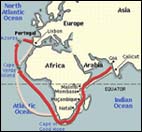The Rediff Special /Archana Masih
Gama thought the Hindu residents of the port city were some kind of Christians
 Vasco da Gama rounded the Cape of Good Hope, passed Mozambique, Kenya and reached Calicut on May 20, 1498. During the voyage,
he twice lost sight of land for ninety days and reached India
with the help of an Arab navigator, Ibn Majid. He met the Zamorin
of Calicut and presented him with gifts far to meagre for the prestige of
an opulent raja.
Vasco da Gama rounded the Cape of Good Hope, passed Mozambique, Kenya and reached Calicut on May 20, 1498. During the voyage,
he twice lost sight of land for ninety days and reached India
with the help of an Arab navigator, Ibn Majid. He met the Zamorin
of Calicut and presented him with gifts far to meagre for the prestige of
an opulent raja.
Other misjudgements followed: He thought the
Hindu residents of the port city were some kind of Christians
and their temples, some kind of churches.
Gama stayed in India for three months and returned to Lisbon
in August. His brother who accompanied him died on the way and
one of his ships had to be burnt because several crew members
contracted disease. He received a hero's welcome in Lisbon
and was made admiral of the Indian ocean by King Manuel I.
He returned in 1502. However, this time with brutal hostility.
His fleet plundered Muslim ships and Gama asked the Zamorin to
expel all Muslims in Calicut. He seized
a ship carrying pilgrims to Mecca, robbed it and killed
more than 300 men, women and children.
Gama's final voyage to India came 21 years later. This time, he was viceroy of Portuguese India. By now his ideas were different,
he wanted to establish trading pacts with locals without colonisation
and conversions. But he served a very short tenure and died
on Christmas Eve, 1524. He was buried in Cochin and fourteen years
later his remains were transported back to Portugal.
Tell us what you think of this feature
|





